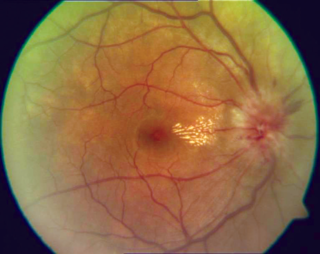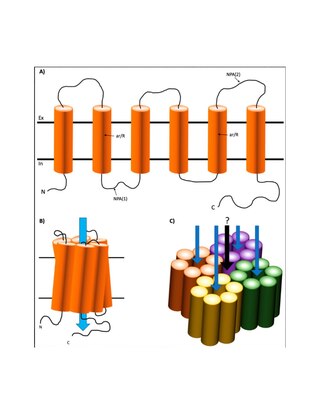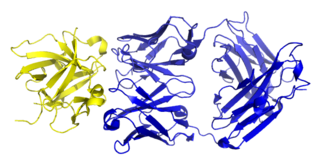Related Research Articles

Optic neuritis describes any condition that causes inflammation of the optic nerve; it may be associated with demyelinating diseases, or infectious or inflammatory processes.
Neuromyelitis optica spectrum disorders (NMOSD), including neuromyelitis optica (NMO), are autoimmune diseases characterized by acute inflammation of the optic nerve and the spinal cord (myelitis). Episodes of ON and myelitis can be simultaneous or successive. A relapsing disease course is common, especially in untreated patients. In more than 80% of cases, NMO is caused by immunoglobulin G autoantibodies to aquaporin 4 (anti-AQP4), the most abundant water channel protein in the central nervous system. A subset of anti-AQP4-negative cases is associated with antibodies against myelin oligodendrocyte glycoprotein (anti-MOG). Rarely, NMO may occur in the context of other autoimmune diseases or infectious diseases. In some cases, the etiology remains unknown.

Myelin oligodendrocyte glycoprotein (MOG) is a glycoprotein believed to be important in the myelination of nerves in the central nervous system (CNS). In humans this protein is encoded by the MOG gene. It is speculated to serve as a necessary "adhesion molecule" to provide structural integrity to the myelin sheath and is known to develop late on the oligodendrocyte.

Aquaporin-4, also known as AQP-4, is a water channel protein encoded by the AQP4 gene in humans. AQP-4 belongs to the aquaporin family of integral membrane proteins that conduct water through the cell membrane. A limited number of aquaporins are found within the central nervous system (CNS): AQP1, 3, 4, 5, 8, 9, and 11, but more exclusive representation of AQP1, 4, and 9 are found in the brain and spinal cord. AQP4 shows the largest presence in the cerebellum and spinal cord grey matter. In the CNS, AQP4 is the most prevalent aquaporin channel, specifically located at the perimicrovessel astrocyte foot processes, glia limitans, and ependyma. In addition, this channel is commonly found facilitating water movement near cerebrospinal fluid and vasculature.
Inflammatory demyelinating diseases (IDDs), sometimes called Idiopathic (IIDDs) due to the unknown etiology of some of them, are a heterogenous group of demyelinating diseases - conditions that cause damage to myelin, the protective sheath of nerve fibers - that occur against the background of an acute or chronic inflammatory process. IDDs share characteristics with and are often grouped together under Multiple Sclerosis. They are sometimes considered different diseases from Multiple Sclerosis, but considered by others to form a spectrum differing only in terms of chronicity, severity, and clinical course.
Tocilizumab, sold under the brand name Actemra among others, is an immunosuppressive drug, used for the treatment of rheumatoid arthritis, systemic juvenile idiopathic arthritis, a severe form of arthritis in children, and COVID‑19. It is a humanized monoclonal antibody against the interleukin-6 receptor (IL-6R). Interleukin 6 (IL-6) is a cytokine that plays an important role in immune response and is implicated in the pathogenesis of many diseases, such as autoimmune diseases, multiple myeloma and prostate cancer. Tocilizumab was jointly developed by Osaka University and Chugai, and was licensed in 2003 by Hoffmann-La Roche.
Mepolizumab, sold under the brand name Nucala by GlaxoSmithKline, is a humanized monoclonal antibody used for the treatment of severe eosinophilic asthma, eosinophilic granulomatosis, and hypereosinophilic syndrome (HES). It recognizes and blocks interleukin-5 (IL-5), a signalling protein of the immune system.

Canakinumab, sold under the brand name Ilaris, is a medication for the treatment of systemic juvenile idiopathic arthritis, active Still's disease, including adult-onset Still's disease, gout flares. It is a human monoclonal antibody targeted at interleukin-1 beta. It has no cross-reactivity with other members of the interleukin-1 family, including interleukin-1 alpha.
Research in multiple sclerosis may find new pathways to interact with the disease, improve function, curtail attacks, or limit the progression of the underlying disease. Many treatments already in clinical trials involve drugs that are used in other diseases or medications that have not been designed specifically for multiple sclerosis. There are also trials involving the combination of drugs that are already in use for multiple sclerosis. Finally, there are also many basic investigations that try to understand better the disease and in the future may help to find new treatments.

Chugai Pharmaceutical Co., Ltd. is a drug manufacturer operating in Japan. It is a subsidiary controlled by Hoffmann-La Roche, which owns 62% of the company as of 30 June 2014. The company is headquartered in Tokyo. Osamu Nagayama is the current representative director and chairman. Tatsuro Kosaka is the current representative director, president and CEO.
Ixekizumab, sold under the brand name Taltz, is an injectable medication for the treatment of autoimmune diseases. Chemically, it is a form of a humanized monoclonal antibody. The substance acts by binding interleukin 17A and neutralizing it, reducing inflammation.

Dupilumab, sold under the brand name Dupixent, is a monoclonal antibody blocking interleukin 4 and interleukin 13, used for allergic diseases such as eczema, asthma and nasal polyps which result in chronic sinusitis. It is also used for the treatment of eosinophilic esophagitis and prurigo nodularis.
Tildrakizumab, sold under the brand names Ilumya and Ilumetri, is a monoclonal antibody designed for the treatment of immunologically mediated inflammatory disorders. It is approved for the treatment of adult patients with moderate-to-severe plaque psoriasis in the United States and the European Union.

Lumateperone, sold under the brand name Caplyta, is an atypical antipsychotic medication of the butyrophenone class. It is approved for the treatment of schizophrenia as well as bipolar depression, as either monotherapy or adjunctive therapy. It is developed by Intra-Cellular Therapies, licensed from Bristol-Myers Squibb. Lumateperone was approved for medical use in the United States in December 2019 with an initial indication for schizophrenia, and became available in February 2020. It has since demonstrated efficacy in bipolar depression and received FDA approval in December 2021 for depressive episodes associated with both bipolar I and II disorders.
MOG antibody disease (MOGAD) or MOG antibody-associated encephalomyelitis (MOG-EM) is an inflammatory demyelinating disease of the central nervous system. Serum anti-myelin oligodendrocyte glycoprotein antibodies are present in up to half of patients with an acquired demyelinating syndrome and have been described in association with a range of phenotypic presentations, including acute disseminated encephalomyelitis, optic neuritis, transverse myelitis, and neuromyelitis optica.
Inebilizumab, sold under the brand name Uplizna, is a medication for the treatment of neuromyelitis optica spectrum disorder (NMOSD) in adults. Inebilizumab is a humanized mAb that binds to and depletes CD19+ B cells including plasmablasts and plasma cells.

Upadacitinib, sold under the brand name Rinvoq, is a medication used for the treatment of rheumatoid arthritis, psoriatic arthritis, atopic dermatitis, ulcerative colitis, Crohn's disease, ankylosing spondylitis, and axial spondyloarthritis. Upadacitinib is a Janus kinase (JAK) inhibitor that works by blocking the action of enzymes called Janus kinases. These enzymes are involved in setting up processes that lead to inflammation, and blocking their effect brings inflammation in the joints under control.
Anti-AQP4 diseases, are a group of diseases characterized by auto-antibodies against aquaporin 4.

Avacopan, sold under the brand name Tavneos, is a medication used to treat anti-neutrophil cytoplasmic autoantibody-associated vasculitis. Avacopan is a complement 5a receptor antagonist and a cytochrome P450 3A4 inhibitor.
Brenda Banwell is Chief of the Division of Neurology and Co-Director of the Neuroscience Center, and Professor of Neurology at Children's Hospital of Philadelphia and holder of the Grace R. Loeb Endowed Chair in Neurosciences. She also holds the title of Professor of Pediatrics and Neurology at the Perelman School of Medicine at the University of Pennsylvania.
References
- 1 2 "AusPAR: Satralizumab". Therapeutic Goods Administration (TGA). 23 August 2021. Retrieved 4 September 2021.
- 1 2 "Enspryng". Therapeutic Goods Administration (TGA). 26 November 2020. Retrieved 10 September 2021.
- ↑ "Satralizumab Product information". Drug Product Database. Health Canada. 25 April 2012. Retrieved 17 August 2020.
- ↑ "Summary Basis of Decision (SBD) for Enspryng". Health Canada. 23 October 2014. Retrieved 29 May 2022.
- 1 2 "Enspryng- satralizumab injection, solution". DailyMed. 24 August 2020. Retrieved 24 September 2020.
- 1 2 3 4 5 6 7 8 9 10 11 12 13 14 15 16 17 18 19 20 21 22 23 24 25 "FDA Approves Treatment for Rare Disease Affecting Optic Nerves, Spinal Cord". U.S. Food and Drug Administration (FDA). 17 August 2020. Retrieved 17 August 2020.
 This article incorporates text from this source, which is in the public domain .
This article incorporates text from this source, which is in the public domain . - 1 2 3 "Enspryng EPAR". European Medicines Agency. 20 April 2021. Retrieved 4 March 2023.
- 1 2 3 4 Heo YA (September 2020). "Satralizumab: First Approval". Drugs. 80 (14): 1477–1482. doi: 10.1007/s40265-020-01380-2 . PMC 7522096 . PMID 32797372.
- ↑ "Chugai Presents Results from Phase III Study of Satralizumab in NMOSD at ECTRIMS 2018".
- 1 2 Rosso M, Saxena S, Chitnis T (May 2020). "Targeting IL-6 receptor in the treatment of neuromyelitis optica spectrum: a review of emerging treatment options". Expert Review of Neurotherapeutics. Informa UK Limited. 20 (5): 509–516. doi:10.1080/14737175.2020.1757434. PMID 32306778. S2CID 216029479.
- 1 2 "Drug Approval Package: Enspryng". U.S. Food and Drug Administration (FDA). 11 September 2020. Retrieved 13 September 2020.
- ↑ "Enspryng Product information". Union Register of medicinal products. Retrieved 3 March 2023.
- 1 2 "New Drug Therapy Approvals 2020". U.S. Food and Drug Administration (FDA). 31 December 2020. Retrieved 17 January 2021.
- 1 2 3 4 5 6 7 8 "Drug Trials Snapshots: Enspryng". U.S. Food and Drug Administration (FDA). 14 August 2020. Retrieved 13 September 2020.
 This article incorporates text from this source, which is in the public domain .
This article incorporates text from this source, which is in the public domain . - 1 2 "Enspryng". compendium.ch (in German). 2020-07-08. Retrieved 2020-08-10.
- ↑ Duchow A, Paul F, Bellmann-Strobl J (September 2020). "Current and emerging biologics for the treatment of neuromyelitis optica spectrum disorders". Expert Opinion on Biological Therapy. Informa UK Limited. 20 (9): 1061–1072. doi:10.1080/14712598.2020.1749259. PMID 32228250. S2CID 214750971.
- 1 2 Traboulsee A, Greenberg BM, Bennett JL, Szczechowski L, Fox E, Shkrobot S, et al. (May 2020). "Safety and efficacy of satralizumab monotherapy in neuromyelitis optica spectrum disorder: a randomised, double-blind, multicentre, placebo-controlled phase 3 trial". The Lancet. Neurology. Elsevier BV. 19 (5): 402–412. doi:10.1016/s1474-4422(20)30078-8. PMC 7935419 . PMID 32333898. S2CID 216055515.
- 1 2 3 Yamamura T, Kleiter I, Fujihara K, Palace J, Greenberg B, Zakrzewska-Pniewska B, et al. (November 2019). "Trial of Satralizumab in Neuromyelitis Optica Spectrum Disorder". The New England Journal of Medicine. Massachusetts Medical Society. 381 (22): 2114–2124. doi: 10.1056/nejmoa1901747 . PMID 31774956.
- ↑ "Enspryng (satralizumab)". Roche. Retrieved 9 August 2020.
- ↑ "Enspryng: FDA-Approved Drugs". U.S. Food and Drug Administration (FDA). Retrieved 17 August 2020.
- ↑ World Health Organization (2017). "International nonproprietary names for pharmaceutical substances (INN): recommended INN: list 78". WHO Drug Information. 31 (3): 552. hdl: 10665/330961 . License: CC BY-NC-SA 3.0 IGO.
- ↑ "Statement On A Nonproprietary Name Adopted By The USAN Council - Satralizumab]" (PDF). American Medical Association. Archived from the original (PDF) on 2018-09-28. Retrieved 2018-09-28.